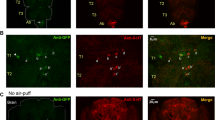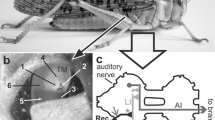Summary
-
1.
Phentolamine was injected into the haemolymph of locusts, Locusta migratoria, and its effects on the flight system were analyzed using electrophysiological techniques.
-
2.
Doses of 150 μl at 10−2 M phentolamine inactivated the wing stretch-receptors and tegulae without influencing the central nervous system (CNS). The lack of effect on the CNS was demonstrated by the absence of any effect on the flight motor pattern in animals that had been mechanically deafferented prior to the administration of phentolamine. From these observations we conclude that phentolamine can be used to chemically deafferent the flight system of the locust. Consistent with this conclusion is that the administration of phentolamine in intact animals changed the flight motor pattern so that it resembled the pattern occurring in mechanically deafferented animals.
-
3.
The two main advantages of deafferenting the flight system by injecting phentolamine were a) intracellular recordings from central neurons could be easily maintained during the process of deafferentation, and b) the contribution of different groups of proprioceptors to the generation of the motor pattern could be assessed since not all proprioceptors were inactivated simultaneously.
-
4.
By intracellularly recording from elevator motoneurons and administering phentolamine we confirmed a number of previous results related to the function of the wing stretch-receptors and the tegulae.
Similar content being viewed by others
References
Ferrell WR, Hart IK (1980) The effect of acute abolition of knee joint afferent discharge on postural reflexes in the conscious cat. Brain Res 202:493–496
Gandevia SC, McCloskey PI (1977) Effects of related sensory inputs on motor performances in man studied through changes in perceived heaviness. J Physiol 272:653–672
Honegger HW, Altman JS, Kien J, Müller-Tautz R, Pollerberg E (1984) A comparative study of neck muscle motoneurons in a cricket and a locust. J Comp Neurol 230:517–535
Kutsch W (1974) The influence of the wing sense organs on the flight motor pattern in maturing adult locusts. J Comp Physiol 88:413–424
Malamud JG, Mizisin AP, Josephson RK (1988) The effects of octopamine on contraction kinetics and power output of a locust flight muscle. J Comp Physiol A 162:827–835
Marsden CD, Merton PA, Morton HB (1977) The sensory mechanism of servo action in human muscle. J Physiol 265:521–535
Marsden CD, Rothwell JC, Traub MM (1979) Effect of thumb anaesthesia on weight perception muscle activity and the stretch reflex in man. J Physiol 294:303–315
Matthews PBC (1958) The effect of the local application of procaine on the stretch reflex of the soleus muscle of the cat decerebrated by anaemia. J Physiol 140:408–420
Matthews PBC (1984) The contrasting stretch reflex responses of the long and short flexor muscles of the human thumb. J Physiol 348:545–559
Matthews PBC, Rushworth G (1957a) The selective effect of procaine on the stretch reflex and tendon jerk of soleus muscle when applied to its nerve. J Physiol 135:245–262
Matthews PBC, Rushworth G (1957b) The relative sensitivity of muscle nerve fibres to procaine. J Physiol 135:263–269
Matthews PBC, Rushworth G (1958) The discharge from muscle spindles as an indicator of gamma efferent paralysis by procaine. J Physiol 140:421–426
McGrath GJ, Matthews PBC (1973) Evidence from the use of vibration during procaine nerve block that the spindle group II fibres contribute excitation to the tonic stretch reflex of the decerebrate cat. J Physiol 235:371–408
Möhl B (1985) The role of proprioception in locust flight. III. The influence of afferent stimulation of the stretch-receptor nerve. J Comp Physiol A 156:281–292
Neumann L (1985) Experiments on tegula function for flight coordination in the locust. In: Gewecke M, Wendler G (eds) Insect locomotion. Paul Parey, Berlin, pp 149–156
Pearson KG, Iles JF (1970) Discharge patterns of coxal levator and depressor motoneurons of the cockroach, Periplane ta americana. J Exp Biol 52:139–165
Pearson KG, Iles JF (1973) Nervous mechanisms underlying intersegmental coordination of leg movements during walking in the cockroach. J Exp Biol 58:725–774
Pearson KG, Ramirez JM (1990) Influence of input from the forewing stretch-receptors on motoneurones in flying locusts. J Exp Biol, in press
Pearson KG, Wolf H (1987) Comparison of motor patterns in the intact and deafferented flight system of the locust. I. Electromyographic analysis. J Comp Physiol A 160:259–268
Pearson KG, Wolf H (1988) Connections of hindwing tegulae with flight neurones in the locust, Locusta migratoria. J Exp Biol 135:381–409
Pearson KG, Reye DN, Parsons DW, Bicker G (1985) Flight initiating interneurons in the locust. J Neurophysiol 53:910–934
Ramirez JM, Orchard I (1990) Octopaminergic modulation of the forewing stretch-receptor in the locust Locusta migratoria. J Exp Biol 149:255–279
Ramirez JM, Orchard I, Pearson KG (1990) Octopaminergic modulation of sense-organs involved in locust flight. In : Borkovec AB, Masler EP (eds) Insect neurochemistry and neurophysiology. Humana Press Inc, pp 421–424
Ramirez JM, Pearson KG (1990) Local anesthetic action of phentolamine on insect mechanoreceptors. J Comp Physiol A 167:475–483
Reye DN, Pearson KG (1988) Entrainment of the locust central flight oscillator by wing stretch-receptor stimulation. J Comp Physiol A 162:77–89
Ritchie JM, Greene NM (1985) Local anesthetics. In: Goodman, Gilman A, Goodman LS, Rall TW, Murad F (eds) The pharmacological basis of therapeutics. Macmillan Publishing Company, New York Toronto London, pp 302–321
Robertson RM, Pearson KG (1982) A preparation for the intracellular analysis of neuronal activity during flight in the locust. J Comp Physiol 146:311–320
Shimamura M, Kogure I, Fuwa T (1984) The role of joint afferents in relation to the initiation of forelimb stepping in thalamic cats. Brain Res 297:225–234
Whim MD, Evans PD (1988) Octopaminergic modulation of flight muscle in the locust. J Exp Biol 134:247–266
Wilson DM, Gettrup E (1963) A stretch reflex controlling wingbeat frequency in grasshoppers. J Exp Biol 40:171–185
Wolf H, Pearson KG (1987) Comparison of motor patterns in the intact and deafferented flight system of the locust. II. Intracellular recordings from flight motoneurons. J Comp Physiol A 160:269–279
Wolf H, Pearson KG (1988) Proprioceptive input patterns elevator activity in the locust flight system. J Neurophysiol 59:1831–1853
Author information
Authors and Affiliations
Rights and permissions
About this article
Cite this article
Ramirez, J.M., Pearson, K.G. Chemical deafferentation of the locust flight system by phentolamine. J Comp Physiol A 167, 485–494 (1990). https://doi.org/10.1007/BF00190819
Accepted:
Issue Date:
DOI: https://doi.org/10.1007/BF00190819




